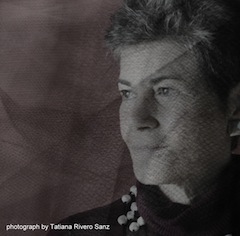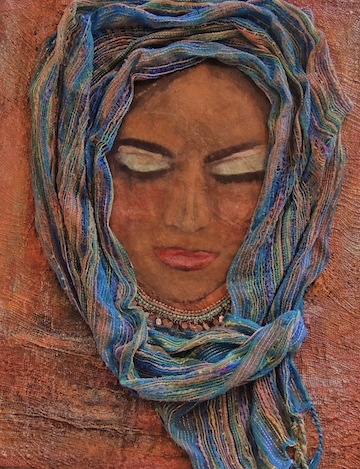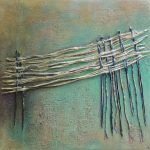Artist Monica Gewurz’s “Woven Tallit” was inspired by her father.
Judaism’s history, traditions and clothing and my Peruvian upbringing are always latent in my inspirations,” artist Monica Gewurz told the Independent.
Gewurz will be one of more than 90 exhibitors at Art! Vancouver, which takes place April 19-22 at the Vancouver Convention Centre East.
“Both of my parents were Polish Jews,” said Gewurz. “My mother left Poland before the war to Palestine as part of the youth aliyah to help establish Israel. My father left Poland to study in France where, after completing his studies, he went to Peru to work for a French mining company. During the British Mandate, my father volunteered to help build the underground tunnels as part of the Jewish resistance. He met my mother and, in three weeks, they were married. My father had to return to work in Peru, where they both stayed. I was born there and left in 1976.”
Though Gewurz’s mother was a nurse, she “had a passion for rendering still life in pastels and watercolours.”
Gewurz left Peru, she said, because of the military situation there, “and the increased level of antisemitism in Peru and in South America in general.” She obtained both her bachelor of science and her master’s in landscape architecture and environmental planning from the University of Guelph, in Ontario, then worked for the federal government in Ottawa until 1987. She moved to Montreal, she said, “to work in the private sector for pension funds and, later on, for Canadian Pacific Railway, working on both environmental decontamination and commercial real estate planning, marketing and sales until December 1997. I moved that year to Vancouver because of the rise of the separatist movement in Quebec and the lack of professional opportunities because I was not fully bilingual.”

During her career, Gewurz has worked in both large-scale commercial real estate development and sales; eco- and cultural tourism planning and marketing; environmental assessment; and for the Canadian government dealing with aboriginal issues. Her work in jewelry, photography and painting began as hobbies. However, in 2014, she received a fine art certificate from Emily Carr University of Art and Design, and embarked on a new career as a professional artist. She is currently enrolled in Emily Carr’s advanced study certificate in painting.
“My textured paintings strive to reflect and connect cultures through the use of ancient and modern materials, colours and techniques,” she said. “I use texture to blur the line between painting and sculpture, integrating man-made elements such as paper, natural elements like semi-precious stones and gravel, and traditional textile designs from various cultures, including Israel and my native Peru.”
Gewurz also travels a lot, which has allowed her to study different art forms, she said. She has been to Peru, Chile, Argentina, Brazil, Bali, France, Germany, Italy, Greece, Switzerland, Spain, Portugal, India, Israel, Turkey, China and several islands in the Caribbean. She said she always tries to visit museums and historical sites when she’s traveling. Last summer, for example, she participated in a guided art tour through the rivers of Holland, which included visits to UNESCO sites.
Her travels and love of archeology and tribal symbolism inspire her art, she said, and lend it broad dimensions.
“I am attracted to the abstraction of stylized figures done in wood, metal or in textiles that are decorated with simple colours … the myriad high relief textures and multicolour metallic patinas that have been created by weathering and the use of metals to indicate status or ceremonial purposes.
“I am also attracted by their simplicity, honesty and inventiveness, and the fact that they are all made with natural materials and pigments,” she said. “Distorted yet primal in its raw geometry, it provides my inspiration to create a new artistic language with new forms, colours and meanings.
“In my paintings, I use an earthy, quiet palette echoing the colour found in metallic patinas, Raku pottery and ancient glass. To accomplish the above, I use intense turquoises, luminous teals and yellows, haunting blues, earthy ochres and siennas, deep burgundies and mysterious charcoals and blacks. I also use metallic paints and foils to accent textures to give my paintings more luminosity.”
Gewurz really does seem to communicate with the earth. Her sea- and landscapes are alive with colour and texture. In some paintings, it’s almost a wonder how the water stays within the frame, its flowing movement captured somehow into a moving stillness.
“My studio is located amidst the rainforest with an ocean vista,” she said. “I am surrounded by the subtleties of changing skies and rhythms of the ocean. Hikes into the local mountains, forests and beaches up the north coast inspire my abstract work.
“The abstraction of the constant changing of shapes, colours and patterns of light in the reflected water and changing skies during sunrises and sunsets mesmerize me and are a source of my inspiration. I am fascinated with the contrasting nature of the organic and how that can provide an escape to a dream-like place.”
As for works in which her Jewishness played an important role, Gewurz offered the Independent a few examples.
The mixed media piece “Woven Tallit,” she said, “was inspired by the one my father wore until he passed away.” It not only depicts a tallit in the early stages of being made, but also symbolizes, she explained, “the tapestry that we call life, where individually we are nothing much more than a single thread intertwined with others, and also the ‘woven’ aspect of the various cultures and religions that have come together to create modern Israel.”
Gewurz created “Rachel de Matriarch I” and “Rachel de Matriarch II” to honour her mother, whose name was also Rachel, and who was “an artist, and had similar abilities and qualities as Rachel the matriarch,” one of the four spiritual matriarchs of the Hebrew Bible, she said, noting that “Rachel means a small lamb, and she is described as ‘beautiful of form and beautiful of appearance’ (Genesis 29:17).”
“Although she is no longer alive,” said Gewurz of her mother, “she continues to guide me in my daily life and artistic journey.

“In terms of symbolism,” she added, “the pose of Rachel is of deep thought, dreaming and hoping for the well-being of all people in the world. The texture, patinas and colour palette of copper, earth tones and turquoise are inspired by the simple but colourful clothes, jewelry and headdresses that Rachel would have worn while working in the fields.
“The many layers of this painting are reminiscent of the layered depth of a person’s life, and like looking into ourselves. While the surface layer is easily recognized and understood, deeper exploration is needed to reveal the complex and veiled richness of the person within.”
The last example Gewurz gave was her “Friendship Shawl,” which she described as “an abstraction of a silk and gold scarf which can be wrapped around the shoulders of two friends. Friendship is one of the key values of Judaism and a fundamental building block of the global community.” This painting was also inspired, she said, “by the patterns formed by the warp and weft of the friendship bracelets woven over the centuries by aboriginal people from Central and South America. According to tradition, a person will tie a string or fabric bracelet around the wrist of a friend while making a wish or prayer for them … the wish will come true if the bracelet is worn until it falls off by itself.”
Gewurz is represented by four different galleries. “I have been represented by Ukama since 2016, the Kube Gallery and Sooke Harbour House Gallery since 2017 and, this year, I will be also represented by Mattick’s Farm Gallery in Victoria,” she said.
In addition to paintings, Gewurz also creates “wearable art.”
“They are all based on my paintings,” she said of these works. “I take a portion of the image and expand it so it is an abstraction of a painting rather than the whole painting. I have been doing it only for one year, mainly as part of participating in the Slow Clothes fashion show held as part of the Harmony Arts Festival every year, and to give them away as a thank you for people that buy my artwork, i.e. somebody who buys a large painting receives a scarf or a pillow as a gift.”
Gewurz also donates a percentage of her sales to the Brooke Foundation, whose mission is to improve “the lives of working horses, donkeys and mules” around the world, and to the SPCA (Society for the Prevention of Cruelty to Animals) in Vancouver. She has donated art to numerous organizations, including the B.C. Cancer Foundation, the Children’s Heart Network Foundation and the Stephen Lewis Foundation’s Grandmothers to Grandmothers Campaign.
“It is a way of giving back to the community that has supported me in the past and continues to support me,” she said. “I like to donate art, money and time: ‘it’s better to give than to receive.’ I also like doing something useful and helping others, which makes me feel good about myself, which increases my self-esteem, and greater personal empowerment and better health.”
Other Jewish artists in the exhibition include Art! Vancouver director Lisa Wolfin – “I am doing a forest with a pipeline going in front of the forest to show what is going on in B.C.,” she told the JI. As well, Wolfin’s sister, LeeAnn Wolfin, and daughters, Taisha Teal Wayrynen and Skyla Wayrynen, will be showing their work. The event also features artist demonstrations and workshops, speakers and panel discussions, dance and other performances. For schedule and ticket information, visit artvancouver.net.

